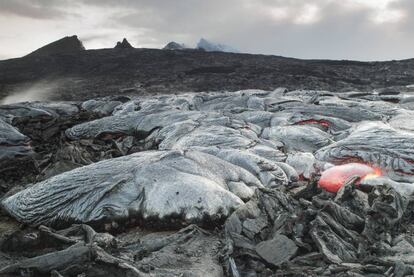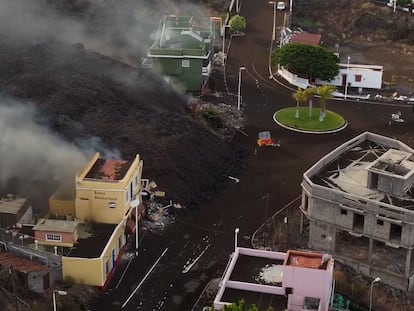How does the eruption in La Palma compare with a supervolcano?
The largest known volcanic blasts can deposit over 1,000 cubic kilometers of material around them, but we only know about these events from geological studies

In volcanology, there is a scale known as the Volcanic Explosivity Index (IEV-VEI), which is an indicator of the size and explosiveness of eruptions. It registers the amount (volume) of material that a volcano expels and the height of the eruption cloud. The IEV-VEI scale ranges from 0 to 8 but it is logarithmic, which means that an increase of 1 on the scale represents an explosion that is 10 times more powerful.
Super-eruptions (also known as mega-colossal eruptions) have an IEV of 8, which is to say that they are the most explosive eruptions on the scale. Supervolcanos emit enormous amounts of material – over 1,000 cubic kilometers. But these eruptions are very infrequent: it has been estimated that a super-eruption occurs only once every 10,000 years or more. For example, there are no super-eruptions in the recent human historical record, although they do exist in the geological record. That is to say, we are sure that they have occurred because they have been studied on the basis of geological deposits.
One of the most famous super-eruptions took place in the United States, inside Yellowstone National Park, and led to the formation of the so-called Yellowstone Caldera 640,000 years ago. The caldera measures 69 x 45 kilometers (43 by 28 miles) and was formed during the Lava Creek eruption. Yellowstone is a supervolcano, like the Diamond Caldera in Chile, which was formed by super-eruptions around 130,000 years ago. These super-volcanoes are generally produced in continental drift zones, where eruptions are more explosive. This has not happened in Spain’s Canary Islands because the archipelago is not on a continental drift, but rather in a hotspot zone.
If a mega-colossal eruption of this kind were to occur on Earth now it would provoke climate change
Although the Teide-Pico Viejo volcano on Tenerife has had more explosive eruptions in the past than that currently seen on La Palma, eruptions there and on the nearby island of El Hierro are generally like the one taking place right now at Cabeza de Vaca volcano, with an IEV of 2 or 3.
We are not sure exactly what causes a super-eruption. The hypothesis is that they have huge magma chambers, vastly bigger than all other volcanos, and that these empty out very suddenly.
If a mega-colossal eruption of this kind were to occur on Earth now it would provoke climate change. Studies have shown that eruptions at the top of the IEV scale pump so much ash into the atmosphere that it would block out the sun’s rays and would lead to changes in climate on a global scale. Furthermore, in the area where the super-eruption took place, devastation would be total because the associated material expelled is generally pyroclastic flow that destroys everything in the vicinity with a range that can extend to hundreds of miles.
The biggest volcano in the Solar System is Olympus Mons (Mount Olympus), on Mars. It is over 21.9 km (13 miles) high with an area the same as the land surface of Spain. However, despite its imposing size, it is not associated with super-eruptions. It is an active shield volcano like Kilauea or Mauna Loa in Hawaii, which are gently sloping volcanoes formed by multiple consecutive eruptions with lava emissions, mainly from not very explosive eruptions.
Laura Becerril Carretero holds a PhD in geology, is an expert in volcanology and a professor and researcher at the Institute of Science and Engineering at O’Higgins University in Chile.
This article is part of Nosotras respondemos, a weekly science column that answers questions from readers and is sponsored by the Dr. Antoni Esteve Foundation and the L’Oréal-Unesco ‘For Women in Science’ program.
Tu suscripción se está usando en otro dispositivo
¿Quieres añadir otro usuario a tu suscripción?
Si continúas leyendo en este dispositivo, no se podrá leer en el otro.
FlechaTu suscripción se está usando en otro dispositivo y solo puedes acceder a EL PAÍS desde un dispositivo a la vez.
Si quieres compartir tu cuenta, cambia tu suscripción a la modalidad Premium, así podrás añadir otro usuario. Cada uno accederá con su propia cuenta de email, lo que os permitirá personalizar vuestra experiencia en EL PAÍS.
¿Tienes una suscripción de empresa? Accede aquí para contratar más cuentas.
En el caso de no saber quién está usando tu cuenta, te recomendamos cambiar tu contraseña aquí.
Si decides continuar compartiendo tu cuenta, este mensaje se mostrará en tu dispositivo y en el de la otra persona que está usando tu cuenta de forma indefinida, afectando a tu experiencia de lectura. Puedes consultar aquí los términos y condiciones de la suscripción digital.
More information
Archived In
Últimas noticias
More than 40 Democratic lawmakers urge Trump in a letter to stop his ‘attempts to undermine democracy in Brazil’
The journal ‘Science’ criticizes Trump’s anti-renewable energy policy: ‘The US is failing to benefit from its own innovations’
Cubans hope for a miracle as dengue and chikungunya spread
The long shadow of the father figure in the films of Rob Reiner
Most viewed
- Christian Louboutin: ‘Young people don’t want to be like their parents. And if their parents wear sneakers, they’re going to look for something else’
- Cartels in Mexico take a leap forward with narco-drones: ‘It is criminal groups that are leading the innovation race’
- ‘El Limones’ and the growing union disguise of Mexican organized crime
- Liset Menéndez de la Prida, neuroscientist: ‘It’s not normal to constantly seek pleasure; it’s important to be bored, to be calm’
- The low-cost creative revolution: How technology is making art accessible to everyone










































